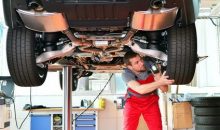CO2 LEVY: WHAT WILL CHANGE FOR LARGE IMPORTERS IN 2020?
Home » CO2 TAX WHEN IMPORTING A CAR INTO SWITZERLAND – EVERYTHING YOU NEED TO KNOW » CO2 LEVY: WHAT WILL CHANGE FOR LARGE IMPORTERS IN 2020?
The CO2 regulation foresees important changes for the beginning of 2020 that will particularly affect large importers and general importers.
Since 2012, passenger cars imported into Switzerland have been subject to a CO2 tax if certain CO2 target values are exceeded, provided that the period between registration abroad and registration with Swiss customs does not exceed six months (the date of the customs stamp is decisive).
- From 2020, significantly reduced CO2 target values will apply to passenger cars.
- In addition, light commercial vehicles (LNF) will also be included in the CO2 tax regulations from 2020.
PERSONAL CAR
For passenger cars, a CO2 target value of 95 grams per kilometre will apply from 2020 (2012 to 2019: 130 g/km). This target value corresponds to a consumption of 3.6 litres of diesel or 4.1 litres of petrol for a distance of 100 kilometres.
In 2018, emissions from imported new passenger cars in Switzerland increased to a fleet average of 137.8 g/km (2017: 134.1 g/km; 2016: 133.6 g/km).
The importers’ association Auto-Switzerland names the following as the causes of this increase in emissions
- the high and increasing share of SUVs in new registrations in Switzerland (SUV share in 2018 according to the Swiss Federal Office of Energy, SFOE: 48.9 percent)
- the introduction of the new international test cycle WLTP (Worldwide Harmonised Light Vehicle Test Procedure), which is intended to ensure globally harmonised and more realistic fuel consumption and emissions tests, as well as
- the decline in the market share of diesel vehicles to 30.2 percent (2017: 36.2 percent) an increase in registrations of passenger cars with petrol engines by about 4 percentage points. Petrol engines emit about 20 percent more CO2 than comparable diesel units.
The CO2 emissions of the Swiss new car fleet are significantly higher than the EU average. Swiss passenger cars have above-average performance ratios compared to the EU fleet. No EU country has such a high market share of four-wheel drive vehicles as Switzerland.
The high emission levels of the Swiss new car fleet are attributed to the higher Swiss purchasing power, but also to the special topographical conditions in Switzerland.
LIGHT COMMERCIAL VEHICLES
Light commercial vehicles (LNF) included in the CO2 emissions regulation from 2020 include delivery vans and light semi-trailer trucks with a maximum total weight of 3.5 tonnes (Article 2 CO2 Ordinance, Article 11(2)(e) and (i) of the Ordinance on Technical Requirements for Road Vehicles, VTS).
The CO2 target value for LNF valid from 2020 is 147 g/km. If this target value for its fleet of light commercial vehicles is exceeded, the importer must pay a CO2 penalty.
In 2018, the Swiss LNF fleet had the highest CO2 emission value in Europe at 183.3 g/km. (The EU average LNF CO2 emissions in 2018 were only 158.1 g/km). The importers’ association Auto-Schweiz sees a major reason for the high CO2 emissions of Swiss LNFs in the performance-based heavy vehicle fee (HVF), which is only levied in this form in Switzerland. According to Auto-Schweiz, the levying of the HVF leads to LNF transports in Switzerland being favoured over lorry transports.
LARGE IMPORTERS: THE AVERAGE VALUES OF A FLEET ARE DECISIVE
Large importers must meet the CO2 target values as an average for the fleet. A large importer is one who annually
- at least 50 PW respectively
- at least 6 LNF
imported into Switzerland.
The implementation of the CO2 emission targets by large importers is ensured by the Swiss Federal Office of Energy (SFOE) in cooperation with the Federal Roads Office (FEDRO).
FORMATION OF EMISSION COMMUNITIES
In accordance with the regulations applicable to PW, importers and manufacturers can also form LNF emission pools. A common CO2 target value applies to the total fleet of all participants in an emissions pool. LNF and PW issuing companies are to be formed independently of each other.
SPECIAL TARGETS FOR LARGE IMPORTERS: NICHE AND SMALL PRODUCERS
Niche and small manufacturers can continue to apply to the Federal Office of Energy for individual special targets for PW fleets and in future also for LNF fleets.
- Small manufacturers are those who produce fewer than 10,000 cars per year.
- A niche manufacturer is one who produces between 10,000 and 300,000 motor vehicles per year.
ELECTRIC CARS SUPPORT THE ACHIEVEMENT OF GOALS
A higher share of electrically powered vehicles in new registrations would make it much easier to achieve the CO2 targets.
Newly registered vehicles that are fully or partially electric are also included in the calculation of average fleet consumption. The amount of electricity consumed is assumed to have a CO2 value of 0 g/km.
SO FAR LOW MARKET SHARE OF E-CARS
However, only 5,408 electric vehicles were registered in Switzerland in 2018. This corresponds to a market share of electric vehicles of only 1.7 percent (2017: 1.5 percent).
E-VEHICLES: HIGH WEIGHTING THROUGH SUPER CREDITS
In order to facilitate the adjustment process, so-called “super credits” will be taken into account when determining the target achievement of a new vehicle fleet: Every new vehicle imported into Switzerland that emits less than 50 g/km CO2 will be taken into account in 2020 with double weighting in the new vehicle fleets of major importers and general importers.
Article 27(3) of the CO2 Ordinance provides for a gradually reduced crediting of vehicles with low CO2 emissions:
- 2020: double,
- 2021: 1.67-fold
- 2022: 1.33-fold.
In order to avoid false incentives, a large importer can only claim Super Credits until the average CO2 emissions of its vehicle fleet have been reduced by 7.5 g/km in arithmetical terms. According to the SFOE, the observation period is from 01.01.2020 to 31.12.2022 and not per calendar year. Thus, the Super Credits (improvement of 7.5 g/km) are not reset every year!
SKILFUL USE OF FREE BOUNDARIES
The achievement of the target will also be facilitated by CO2 exemption limits: in 2020, those new cars that belong to the 15 percent of vehicles in a new car fleet with the highest CO2 emissions will not be included in the calculation of target achievement. In 2020, therefore, only the most efficient 85 per cent of a new car fleet will be taken into account when calculating CO2 target attainment.
The proportion of vehicles with the highest CO2 emissions that are not included in the determination of target achievement will be gradually reduced over the years (“phasing-in” procedure). Article 27(2) of the CO2 Regulation provides for the inclusion of an annually increasing fleet share in the calculation of the CO2 average (the vehicles of a fleet with the lowest CO2 emissions are taken into account in each case):
- 2020: 85 percent,
- 2021: 90 percent,
- 2022: 95 percent
IMPORTERS’ ASSOCIATION: 10/20 TARGET AND DEMANDS ON POLICYMAKERS
The importers’ association Auto-Switzerland formulated a “10/20” target to give importers a point of reference on the way to achieving the CO2 targets: By 2020, 10 percent of new registrations should be accounted for by pure electric vehicles and 10 percent by plug-in hybrids.
Auto-Schweiz believes that greater political support for electromobility is necessary in order to meet the CO2 targets. In the opinion of the association, the following is required in particular
- the expansion of refuelling and charging infrastructures for alternative vehicle drives,
- the harmonisation of the cantonal differences in the levying of vehicle taxes, and
- the preference for models with low CO2 emissions.
MINIMISING CO2 TAX: CO2 TARGET VALUES AS A CHALLENGE FOR SWISS IMPORTERS
The new CO2 limit for light commercial vehicles and the significant reduction of the target value for passenger cars place high demands on large importers and general importers. In order to minimise the otherwise threatening CO2 tax, it seems sensible to pay attention to fleet imports that are as balanced as possible with regard to CO2 emissions, to increase the import of electrically powered vehicles where possible and to make clever use of the CO2 regulation’s exemption regulation.
HANDLING OF THE CO2 LEVY VIA THE CO2 EXCHANGE AG 2020
CO2 Börse AG strives to also be able to offer you, as a large and small importer, solutions in 2020 for the area of the CO2 levy.
At the moment, it cannot yet be communicated at what conditions and in what form the settlement will be made possible. As soon as all preparations for 2020 have been completed, we will let you know.
CO2 CALCULATION AND PROCESSING TOOL 2020
The changes to the 2020 CO2 levy have a direct impact on your CO2 pool calculation. To provide you with full transparency and simple processing, we developed the CO2 Cockpit 2020 for you:
BASIC MODULE (PASSENGER CARS / LIGHT COMMERCIAL VEHICLES)
The basic module allows you to calculate the CO2 emissions for your fleet online at any time. The calculation takes into account the CO2 Super Credits, the exemption limits and includes a forecasting function.
+ PREPARATION AND PROCESSING OF THE ASSIGNMENT FORMS
Optionally, the module “Creation and processing of assignment forms” can be added. You receive an online form for entering the vehicle values, upload the documents (13.20 A and COC/ TG sheet) and select the procedure (MFK or self-acceptance). The assignment is automatically sent to Astra during self-acceptance or to you directly during MFK.
+ DOCUMENT ARCHIVE
In addition, you can save all vehicle documents in your CO2 Cockpit after the assignment and retrieve them at any time.
Would you like to learn more about the CO2 Cockpit?











